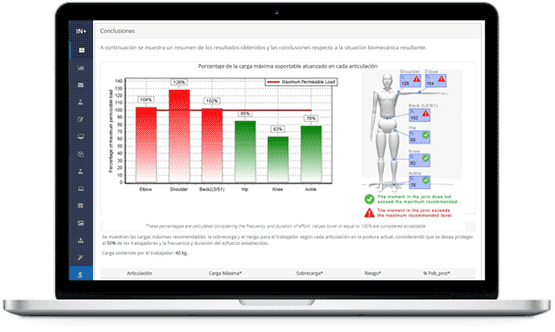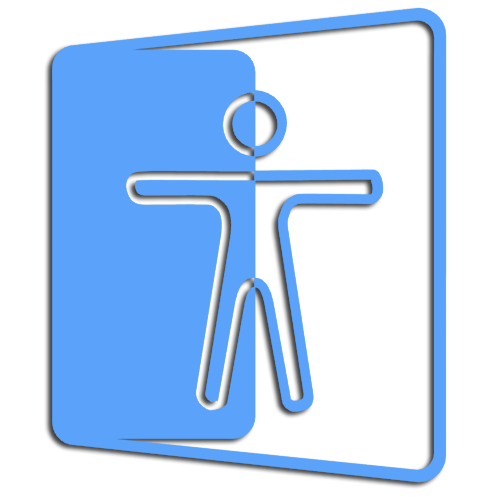

Excessive postural strain is a common risk factor associated with the development of musculoskeletal disorders. Frequently or repeatedly adopting improper postures at work can lead to fatigue and, over time, may cause health problems. Therefore, assessing and reducing postural or static load, if necessary, is a vital step in improving workstation ergonomics.
Various methods exist for assessing the risk associated with postural load. These methods differ in terms of their application scope, the evaluation of individual or sets of postures, application conditions, and the body parts evaluated or considered for evaluation. REBA is a widely-used observational method for assessing postures in practice, based on the well-known RULA method. Its primary distinction is the inclusion of lower extremities in the evaluation (REBA stands for Rapid Entire Body Assessment).
REBA enables a comprehensive analysis of the positions adopted by the upper body limbs (arm, forearm, wrist), trunk, neck, and legs. To develop the method, the authors, with the support of a team of ergonomists, physiotherapists, occupational therapists, and nurses, assessed approximately 600 work postures. Simple tasks with variations in load and movements were analyzed to define body segments. The study incorporated several previously developed methods, including the NIOSH equation (Waters et al., 1993), the Rating of Perceived Exertion scale (Borg, 1985), the OWAS method (Karhu et al., 1994), the BPD technique (Corlett and Bishop, 1976), and the RULA method (McAtamney and Corlett, 1993).
The RULA method played a crucial role in developing the angular ranges of different body parts' positions, resulting in significant similarities between the two methods. Besides the posture itself, REBA assesses other influential factors in physical load, such as the handled load or force, grip type, and the type of muscular activity performed by the worker (encompassing both static and dynamic postures). Unlike the RULA method, REBA also considers sudden posture changes, unstable postures, and whether the arms' posture is maintained in favor of gravity.
REBA is particularly sensitive to tasks involving unexpected posture changes, typically due to handling unstable or unpredictable loads. This method helps evaluators identify the risk of injuries associated with a posture, primarily musculoskeletal injuries, and indicates the urgency for implementing corrective actions.
Remember...
The primary objective of REBA is to assess the worker's exposure to risk due to adopting inadequate postures.
While the method takes into account factors such as exerted forces and repetitiveness, it should primarily be used to assess postural loading.
Remember...
REBA stands for Rapid Entire Body Assessment. Unlike the RULA method, which focuses on assessing static load in the upper extremities, REBA evaluates postural risk for the entire body.
Remember, REBA...
Is particularly sensitive to musculoskeletal risks.
- Divides the body into individually coded segments, covering both upper limbs and the trunk, neck, and legs.
- Analyzes the impact of postural load from handling loads with hands or other body parts.
- Considers the type of grip used for load handling.
- Assesses muscle activity resulting from static postures, dynamic postures, and sudden or unexpected posture changes.
- Determines the risk level of potential injuries, establishing the required action level and urgency for intervention.
The REBA method focuses on evaluating individual postures rather than sets or sequences of postures. Consequently, it is essential to properly select the postures for assessment from those adopted by the worker during the task performed. Prioritize postures with the highest postural load, either due to their duration, frequency, or significant deviation from the neutral position.
First, observe the tasks performed by the worker. Watch several work cycles and determine the postures to be evaluated. If the cycle is lengthy or non-existent, conduct evaluations at regular intervals, considering the time spent in each posture.
The measurements taken on the worker's adopted postures are primarily angular (angles formed by different body parts relative to specific references). These measurements can be made directly on the worker using angle protractors, electrogoniometers, or any device that allows angular data collection. Alternatively, use photographs of the worker in the studied posture and measure the angles on them. If using photographs, take a sufficient number of shots from different perspectives (elevation, profile, detail views, etc.). Ensure that the angles measured appear in true magnitude in the images, meaning that the plane in which the angle is measured is parallel to the camera plane (Figure 1). For this task, you can use RULER, Ergonizas' tool for measuring angles in photographs or videos.
Apply the method separately to the right and left sides of the body. The expert evaluator can initially choose the side that seems to bear greater postural load. However, if in doubt, it is preferable to analyze both sides.
Remember...
REBA assesses individual postures rather than sets or sequences of postures. Postures to be evaluated are selected based on their duration, frequency, or significant deviation from the neutral position.
Remember...
When using photographs to measure angles, ensure they display angles in true magnitude (see Figure 1).
RULER...
Use RULER, Ergonizas' tool, to measure angles in photographs or videos of the worker performing their task.
Remember...
Evaluate the right and left sides of the body separately. In case of doubt, analyze both sides.
Remember...
... REBA divides the body into two groups.
Group A: includes legs, trunk, and neck
Group B: includes the upper limbs (arms, forearms, and wrists).
Remember...
... the scores for each group (scores A and B) are obtained by scoring each member within the group and consulting the corresponding table.
REBA divides the body into two groups: Group A, comprising the legs, trunk, and neck, and Group B, consisting of the upper limbs (arms, forearms, and wrists). Using the method's associated tables, a score is assigned to each body area (legs, wrists, arms, trunk, etc.) to determine global values for both Group A and Group B based on these scores.
The key to assigning scores to the limbs lies in measuring the angles formed by different body parts of the worker. The method specifies how to measure the angle for each limb. Subsequently, the global scores for Groups A and B are adjusted based on the type of muscular activity performed, grip type and quality when handling objects, and the force applied during the task. Finally, the overall score is derived from these modified global values.
The final value provided by the REBA method is proportional to the risk associated with performing the task, meaning higher values indicate a greater risk of developing musculoskeletal injuries. The method organizes the final scores into action levels that guide the evaluator on the decisions to be made. The proposed action levels range from level 0, which estimates that the evaluated posture is acceptable, to level 4, which indicates an urgent need for changes in the activity.
The procedure for applying the REBA method can be summarized in the following steps:
Determine the work cycles and observe the worker during several of these cycles
If the cycle is very long or there are no cycles, evaluations can be performed at regular intervals.Select the postures to be evaluated
Choose those that, a priori, represent a higher postural load due to their duration, frequency, or deviation from the neutral position.Determine whether to evaluate the left side or the right side of the body
In case of doubt, analyze both sides.Take the required angular data
You can take photographs from the appropriate viewpoints to perform the measurements. For this task, you can use RULER, Ergoniza's tool for measuring angles on photographs or videos.Calculate scores for each body part
Utilize the appropriate tables for each body part to determine scores.Compute partial and final scores to identify risks and establish the Action Level
Identify necessary measures based on scores
Analyze the scores for each body part to determine which areas need adjustments.Modify workstation or implement changes to improve posture as needed
Reassess posture using REBA method after making changes to confirm their effectiveness
The following sections explain how to calculate scores for each body part, determine partial and final scores, and establish the action level.
To calculate the score for Group A, determine the scores for each of its components: trunk, neck, and legs. Start by assessing the individual scores for each body part.
Trunk Score
The trunk score is based on the trunk flexion angle, which is measured by the angle between the trunk axis and the vertical. Refer to Figure 3 for measurement guidance. Use Table 1 to obtain the trunk score.
| Position | Score |
|---|---|
| Upright trunk | 1 |
| Flexion or extension between 0° and 20° | 2 |
| Flexion >20° and ≤60° or extension >20° | 3 |
| Flexion >60° | 4 |
The initial score evaluates trunk flexion. If there is rotation or lateral inclination of the trunk, add one point to the score. If neither occurs, the trunk score remains unchanged. To determine the final trunk score, consult Table 2 and Figure 4.
| Position | Score |
|---|---|
| Trunk with lateral inclination or rotation | +1 |
Neck Score
The neck score is based on the flexion/extension angle formed between the head axis and the trunk axis. There are three possibilities: neck flexion less than 20°, neck flexion greater than 20°, and extension. Refer to Figure 5 for the scores assigned to each head position. Alternatively, use Table 3 to determine the neck score.
| Position | Score |
|---|---|
| Flexion between 0° and 20° | 1 |
| Flexion >20° or extension | 2 |
The initial score evaluates neck flexion. If the head is rotated or exhibits lateral inclination, add one point to the score. If neither occurs, the neck score remains unchanged. To determine the final neck score, consult Table 4 and Figure 6.
| Position | Score |
|---|---|
| Head rotated or with lateral inclination | +1 |
Leg Score
The leg score is determined by the weight distribution between the legs and the available supports. Use Table 5 or Figure 7 to obtain the leg score.
| Position | Score |
|---|---|
| Seated, walking, or standing with symmetrical bilateral support | 1 |
| Standing with unilateral support, light support, or unstable posture | 2 |
The leg score may increase if one or both knees are flexed (see Table 6 and Figure 8). The increase can be up to 2 points if there is flexion over 60°. If the worker is seated and there is no bend, the leg score will not increase.
| Position | Score |
|---|---|
| Flexion in one or both knees between 30 and 60° | +1 |
| Flexion in one or both knees of more than 60° (except seated posture) | +2 |
The Group B score is calculated based on the individual scores of its components (arm, forearm, and wrist). As an initial step, the scores for each component must be determined. Since the method evaluates only one side of the body (left or right), data for Group B must be collected from just one side.
Arm Score
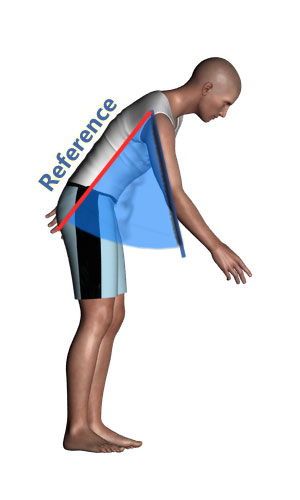 The arm score is determined by the arm's flexion/extension, which is measured by the angle between the arm's axis and the trunk's axis. Figure 9 displays the various degrees of flexion/extension considered by the method. Use Table 7 to calculate the arm score.
The arm score is determined by the arm's flexion/extension, which is measured by the angle between the arm's axis and the trunk's axis. Figure 9 displays the various degrees of flexion/extension considered by the method. Use Table 7 to calculate the arm score.
This score assesses arm flexion. The score will increase by one point if there is shoulder elevation, arm abduction (separation from the trunk in the sagittal plane), or arm rotation. If there is a support point on which the worker's arm rests while performing the task, the arm score will decrease by one point. If none of these circumstances are present, the arm score remains the same.
Additionally, the presence of support points for the arm or adopting a position that favors gravity is considered to reduce risk. In these cases, the initial arm score is decreased. An example is when the trunk is bent forward and the arm hangs vertically. To obtain the final arm score, refer to Table 8 and Figure 10.
| Position | Score |
|---|---|
| From 20° extension to 20° flexion | 1 |
| Extension >20° or flexion >20° and <=45° | 2 |
| Flexion >45° and <=90° | 3 |
| Flexion >90° | 4 |
| Position | Score |
|---|---|
| Abducted or rotated arm | +1 |
| Raised shoulder | +1 |
| Support point exists or posture in favor of gravity | -1 |
Forearm Score
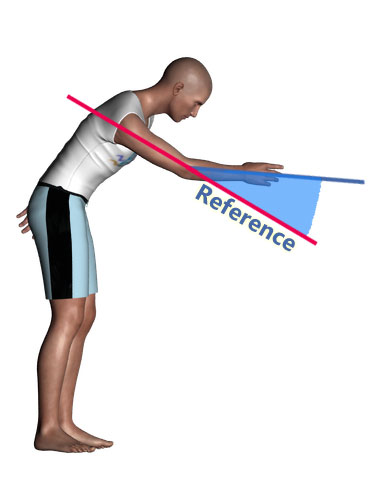 The forearm score is obtained based on its flexion angle, measured as the angle formed by the axis of the forearm and the axis of the arm. Figure 11 shows the flexion intervals considered by the method. The forearm score is obtained using Table 9.
The forearm score is obtained based on its flexion angle, measured as the angle formed by the axis of the forearm and the axis of the arm. Figure 11 shows the flexion intervals considered by the method. The forearm score is obtained using Table 9.
The forearm score will not be modified by any additional circumstances, as the score obtained from flexion is considered final.
| Position | Score |
|---|---|
| Flexion between 60° and 100° | 1 |
| Flexion <60° or >100° | 2 |
Wrist Score
The wrist score is determined by measuring the angle of flexion/extension from the neutral position. Figure 12 provides the references for taking this measurement. Use Table 10 to obtain the wrist score.
| Position | Score |
|---|---|
| Neutral position | 1 |
| Flexion or extension > 0° and <15° | 1 |
| Flexion or extension >15° | 2 |
This score evaluates wrist flexion. The score will increase by one point if there is radial or ulnar deviation of the wrist, or if torsion is present (Figure 13). Refer to Table 11 for the applicable increase.
| Position | Score |
|---|---|
| Torsion or Deviation (Radial or Ulnar) | +1 |
Once the scores for each component in Groups A and B have been determined, you can calculate the overall scores for each group. To obtain the Group A score, refer to Table 12. For the Group B score, consult Table 13.
| Neck | ||||||||||||
| 1 | 2 | 3 | ||||||||||
| Legs | Legs | Legs | ||||||||||
| Trunk | 1 | 2 | 3 | 4 | 1 | 2 | 3 | 4 | 1 | 2 | 3 | 4 |
| 1 | 1 | 2 | 3 | 4 | 1 | 2 | 3 | 4 | 3 | 3 | 5 | 6 |
| 2 | 2 | 3 | 4 | 5 | 3 | 4 | 5 | 6 | 4 | 5 | 6 | 7 |
| 3 | 2 | 4 | 5 | 6 | 4 | 5 | 6 | 7 | 5 | 6 | 7 | 8 |
| 4 | 3 | 5 | 6 | 7 | 5 | 6 | 7 | 8 | 6 | 7 | 8 | 9 |
| 5 | 4 | 6 | 7 | 8 | 6 | 7 | 8 | 9 | 7 | 8 | 9 | 9 |
| Forearm | ||||||
| 1 | 2 | |||||
| Wrist | Wrist | |||||
| Arm | 1 | 2 | 3 | 1 | 2 | 3 |
| 1 | 1 | 2 | 2 | 1 | 2 | 3 |
| 2 | 1 | 2 | 3 | 2 | 3 | 4 |
| 3 | 3 | 4 | 5 | 4 | 5 | 5 |
| 4 | 4 | 5 | 5 | 5 | 6 | 7 |
| 5 | 6 | 7 | 8 | 7 | 8 | 8 |
| 6 | 7 | 8 | 8 | 8 | 9 | 9 |
The overall scores for Groups A and B consider the worker's posture. Next, you'll assess the forces exerted to modify the Group A score and the type of grip on objects to modify the Group B score.
The load handled or force applied will modify the Group A score (trunk, neck, and legs), unless the load is less than 5 kilograms, in which case the score will remain unchanged. Table 14 displays the adjustments to be made based on the weight of the load. Additionally, if the force is applied sharply, add one more point to the previous score (Table 15). From this point, the Group A score, increased by the load or force, will be referred to as Score A.
The quality of object gripping with the hand will affect the Group B score, except when the grip quality is good or no grips are involved. Table 16 presents the adjustments to apply according to grip quality, while Table 17 provides examples for categorizing grip quality. The Group B score, modified by grip quality, will be called Score B.
| Load or force | Score |
|---|---|
| Load or force less than 5 kg | 0 |
| Load or force between 5 and 10 kg | +1 |
| Load or force greater than 10 kg | +2 |
| Load or force | Score |
|---|---|
| Sudden loads or forces applied sharply | +1 |
| Grip quality | Description | Score |
|---|---|---|
| Good | Good grip with mid-range grip strength | 0 |
| Average | Acceptable but not ideal grip, or acceptable grip using other body parts | +1 |
| Poor | Possible but not acceptable grip | +2 |
| Unacceptable | Clumsy and insecure grip, manual grip not possible, or unacceptable grip using other body parts | +3 |
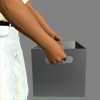 Good grip: Grips performed with optimally designed containers featuring handles or handholds, or those on objects without a container that allow a comfortable grip with hands easily accommodated around the object.
Good grip: Grips performed with optimally designed containers featuring handles or handholds, or those on objects without a container that allow a comfortable grip with hands easily accommodated around the object.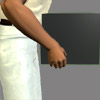 Average grip: Grips performed on containers with non-optimal handles or handholds due to inadequate size, or those involving holding the object by bending the fingers 90º.
Average grip: Grips performed on containers with non-optimal handles or handholds due to inadequate size, or those involving holding the object by bending the fingers 90º.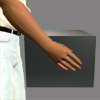 Poor grip: Grips performed on poorly designed containers, bulky objects, irregular shapes, or objects with edges, as well as those carried out without bending the fingers, holding the object by pressing on its sides.
Poor grip: Grips performed on poorly designed containers, bulky objects, irregular shapes, or objects with edges, as well as those carried out without bending the fingers, holding the object by pressing on its sides.The scores for Groups A and B have been adjusted, resulting in Score A and Score B, respectively. Utilizing these two scores and referring to Table 18, the Score C will be determined.
| Score B | ||||||||||||
| Score A | 1 | 2 | 3 | 4 | 5 | 6 | 7 | 8 | 9 | 10 | 11 | 12 |
| 1 | 1 | 1 | 1 | 2 | 3 | 3 | 4 | 5 | 6 | 7 | 7 | 7 |
| 2 | 1 | 2 | 2 | 3 | 4 | 4 | 5 | 6 | 6 | 7 | 7 | 8 |
| 3 | 2 | 3 | 3 | 3 | 4 | 5 | 6 | 7 | 7 | 8 | 8 | 8 |
| 4 | 3 | 4 | 4 | 4 | 5 | 6 | 7 | 8 | 8 | 9 | 9 | 9 |
| 5 | 4 | 4 | 4 | 5 | 6 | 7 | 8 | 8 | 9 | 9 | 9 | 9 |
| 6 | 6 | 6 | 6 | 7 | 8 | 8 | 9 | 9 | 10 | 10 | 10 | 10 |
| 7 | 7 | 7 | 7 | 8 | 9 | 9 | 9 | 10 | 10 | 11 | 11 | 11 |
| 8 | 8 | 8 | 8 | 9 | 10 | 10 | 10 | 10 | 10 | 11 | 11 | 11 |
| 9 | 9 | 9 | 9 | 10 | 10 | 10 | 11 | 11 | 11 | 12 | 12 | 12 |
| 10 | 10 | 10 | 10 | 11 | 11 | 11 | 11 | 12 | 12 | 12 | 12 | 12 |
| 11 | 11 | 11 | 11 | 11 | 12 | 12 | 12 | 12 | 12 | 12 | 12 | 12 |
| 12 | 12 | 12 | 12 | 12 | 12 | 12 | 12 | 12 | 12 | 12 | 12 | 12 |
Finally, to determine the Final Score, the recently calculated Score C will be adjusted based on the type of muscular activity involved in the task. The three types of activity considered by the method are not mutually exclusive, so the Final Score could be up to 3 units higher than the Score C (Table 20).
| Type of muscular activity | Score |
|---|---|
| One or more body parts remain static, for example, supported for more than 1 minute | +1 |
| Repetitive movements occur, for example, repeated more than 4 times per minute (excluding walking) | +1 |
| Significant posture changes or unstable postures are adopted | +1 |
Once the final score is determined, various Action Levels are proposed for the posture. The higher the score, the higher the risk for the worker; a score of 1 indicates negligible risk, while the maximum score of 15 indicates a very high risk and immediate action should be taken. The scores are classified into 5 ranges, each associated with an Action Level. Each Level establishes a risk level and recommends action for the evaluated posture, indicating the urgency of intervention in each case. Table 21 displays the Action Levels based on the final score.
| Score | Level | Risk | Action |
|---|---|---|---|
| 1 | 0 | Negligible | No action needed |
| 2 or 3 | 1 | Low | Action may be needed. |
| 4 to 7 | 2 | Moderate | Action is needed. |
| 8 to 10 | 3 | High | Action is needed as soon as possible. |
| 11 to 15 | 4 | Very high | Immediate action is needed. |
Corlett, E. N, Bishop, R.P, 1976. A technique for assessing postural discomfort. Ergonomics 19 (2), pp. 175 -182.
Diego-Mas, J.A., Poveda-Bautista, R. y Garzon-Leal, D.C., 2015. Influences on the use of observational methods by practitioners when identifying risk factors in physical work. Ergonomics, 58(10), pp. 1660-70.
Hignett, S., 1994. Using computerised OWAS for postural analysis of nursing work. In: Robertson,S. (Ed.),Contemporary Ergonomics. Taylor and Francis,London, pp. 253-258.
Hignett, S. y McAtamney, L, 2000. REBA: Rapid Entire Body Assessment. Applied Ergonomics, 31, pp.201-205.
Karhu, O., Kansi, P., y Kuorinka, L., 1997. Correcting working postures in industry: A practical method for analysis. Applied Ergonomics, 8, pp. 199-201.
McAtamney, L. Y Corlett, E. N., 1993. RULA: A survey method for the investigation of work-related upper limb disorders. Applied Ergonomics, 24, pp. 91-99.
Waters, T.R., Putz-Anderson, V.,Garg, A., Fine, L.J., 1993. Revised NIOSH equation for the design and evaluation of manual lifting tasks. Ergonomics 36 (7).
Diego-Mas, Jose Antonio. Ergonomics assessment of postures using the REBA method. Ergonautas, Universidad Politécnica de Valencia, 2023. Available online: https://www.ergonautas.upv.es/ergoniza/app_en/land/index.html?method=reba
A cloud based software that integrates more than 20 tools for managing the ergonomics of the workstations in your company.
Evaluate all ergonomic risk factors of the workstations in your company: inadequate postures, repetitive movements, load handling, thermal environment...

Use Artificial Intelligence for the automated detection of postures in photographs or videos.
Generate fully customizable reports in Microsoft Word or Adobe Pdf format.
In a multiuser environment so that your company can have access to your data everywhere.
You only need a free account on Ergoniza
ERGONIZA allows you to use Artificial Intelligence for postural load assessment. Automatically capture workers’ postures from a photograph or a video and obtain an automated evaluation of the risk associated with inadequate or forced postures.
AI in actionERGONIZA helps you manage the ergonomics of the workstations of your companies. Evaluate all the risk factors present in the workstations, manage the evaluations, and obtain editable and customizable reports.
You only need to register as a user of ERGONIZA to start testing.
Sign UpUnlock the full potential of Ergoniza. By becoming a Pro User you'll have access to all of Ergoniza and be able to use all of the online software without restrictions or time limits. You'll be able to use the results of evaluation methods and tools in your professional activity. You'll be able to print the results reports in pdf or Word and save your studies in files to open them later.
To register as a Pro user, you must first login to Ergoniza.
(*) In European Union countries, the price will be increased with the corresponding VAT.
(**) The price in american dollars has been calculated at the current exchange rate and may vary.
is a web by . Ergonautas is the specialized website in occupational ergonomics and ergonomic assessment of workstations at the . Ergonautas aims to be a useful support tool for the Occupational Risk Prevention and Ergonomics professional and people in training, providing rigorous technical information on occupational ergonomics, online tools for its application, research, training, and participation forums.
Ergonautas is formed by a large human team. In addition to technicians and programmers, the Ergonautas team is made up of researchers and professors from the Polytechnic University of Valencia. The team, led by José Antonio Diego Más, is at the forefront of research and teaching in ergonomics, teaching in official degrees and master's degrees, and developing research projects in the field of ergonomics and new technologies oriented towards humans.
If you need to know more, get in touch with Ergonautas
Or follow us on Linkedin
- - -
© 2006 - Universidad Politécnica de Valencia
